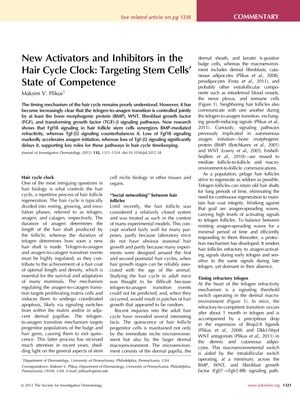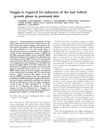New Activators and Inhibitors in the Hair Cycle Clock: Targeting Stem Cells’ State of Competence
April 2012
in “
Journal of Investigative Dermatology
”
BMP WNT FGF TGF-ß Fgf18 Tgf-ß2 telogen phase anagen phase hair follicle microenvironment macroenvironment inter-follicular communication androgenic alopecia hair cycle stem cell niches bone morphogenetic protein wingless-related integration site fibroblast growth factor transforming growth factor beta hair growth cycle hair loss hair growth phases

TLDR The conclusion is that Fgf18 and Tgf-ß signaling could be targeted for hair loss treatments.
The document from 2012 discusses the role of signaling pathways, specifically BMP, WNT, FGF, and TGF-ß, in the regulation of the hair cycle, focusing on the transition from telogen to anagen phases. It reveals that Fgf18 and Tgf-ß2 signaling are critical in timing the hair cycle, with Fgf18 maintaining telogen phase and Tgf-ß2 delaying anagen initiation. The paper also explores the hair follicle's microenvironment and macroenvironment, as well as inter-follicular communication. It suggests that analyzing long-term hair growth patterns can help understand hair cycle defects, which is particularly relevant in androgenic alopecia where the anagen phase is shortened. The document concludes by proposing Fgf18 and Tgf-ß signaling as potential therapeutic targets for hair loss treatments, emphasizing the importance of further research into how these pathways regulate the hair cycle within stem cell niches.









